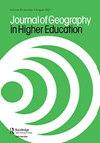Negotiating applied and critical perspectives within the geography curriculum
IF 1
4区 教育学
Q2 EDUCATION & EDUCATIONAL RESEARCH
引用次数: 3
Abstract
Changes that have impacted higher education systems internationally in recent years have included growth in participation rates accompanied by fee and funding reforms that have passed the financial burden of higher education from the state to the individual through higher student fees, increased marketisation and competition between disciplines and institutions, and increased scrutiny through metrics linked primarily to student satisfaction, graduate outcomes and employability. These changes have thrown the question of the “value” of a university education into ever sharper relief, where value is increasingly measured in terms of graduate employability and earning potential, but also, perhaps, through the contributions of universities and their graduates to the social (and environmental) good. There is, then, growing pressure on university courses to demonstrate this value through both their relevance to addressing real world challenges and to producing graduates equipped with skills appropriate to rapidly changing and increasingly precarious job markets. Within Geography this highlights the ongoing relevance of long-standing debates about the potentials of applied geographies (Boyle et al., 2020; Coppock, 1974; Harvey, 1974; Pacione, 2004) and their incorporation into Geography higher education curricula. However, it also raises questions of how these applied perspectives might sit alongside more critical, theoretical perspectives within curricula. Most fundamentally it raises questions of the balance between applied and critical perspectives within Geography higher education curricula and whether one becomes privileged over the other. Exploring this further, we might imagine other pressing questions. Do these critical and applied perspectives sit alongside each other in situations of constructive dialogue, suspicion and hostility, or indifference? What does the co-presence of these perspectives say about the coherence of Geography curricula now, and what are the student experiences and understandings of this? Can, and how might, critical and applied perspectives work productively together and enhance the student experience and understanding of Geography and what challenges do they raise? Are there particular “spaces” in the curriculum where these perspectives are most productively deployed and explored在地理课程中讨论应用和批判的观点
近年来,影响国际高等教育体系的变化包括参与率的增长,以及费用和资金改革,这些改革通过提高学生学费将高等教育的经济负担从国家转嫁给个人,增加了学科和机构之间的市场化和竞争,并通过主要与学生满意度、毕业生成果和就业能力相关的指标加强了审查。这些变化使大学教育的“价值”问题变得更加突出,价值越来越多地以毕业生的就业能力和收入潜力来衡量,但也可能通过大学及其毕业生对社会(和环境)的贡献来衡量。因此,大学课程面临着越来越大的压力,要求它们通过与应对现实世界挑战的相关性,以及培养具备适应快速变化和日益不稳定的就业市场的技能的毕业生,来证明这种价值。在地理学中,这突出了关于应用地理学潜力的长期争论的持续相关性(Boyle等人,2020;Coppock, 1974;哈维,1974;Pacione, 2004),并将其纳入地理高等教育课程。然而,它也提出了一个问题,即这些应用视角如何在课程中与更具批判性的理论视角并存。最根本的是,它提出了在地理高等教育课程中应用和批判观点之间的平衡问题,以及一种观点是否优于另一种观点。进一步探讨这个问题,我们可能会想到其他紧迫的问题。在建设性对话、怀疑和敌意或冷漠的情况下,这些批判和应用的观点是否彼此并存?这些观点的共存说明了现在地理课程的连贯性,学生对此的体验和理解是什么?批判性视角和应用视角能否,以及如何有效地协同工作,增强学生对地理的体验和理解,以及它们带来了什么挑战?课程中是否有特定的“空间”可以最有效地运用和探索这些观点
本文章由计算机程序翻译,如有差异,请以英文原文为准。
求助全文
约1分钟内获得全文
求助全文
来源期刊

Journal of Geography in Higher Education
Multiple-
CiteScore
5.80
自引率
9.50%
发文量
29
期刊介绍:
The Journal of Geography in Higher Education ( JGHE) was founded upon the conviction that the development of learning and teaching was vitally important to higher education. It is committed to promote, enhance and share geography learning and teaching in all institutions of higher education throughout the world, and provides a forum for geographers and others, regardless of their specialisms, to discuss common educational interests, to present the results of educational research, and to advocate new ideas.
 求助内容:
求助内容: 应助结果提醒方式:
应助结果提醒方式:


